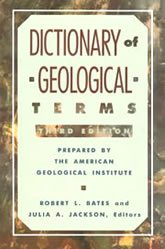Geological Terms Beginning With "B"
For terms beginning with other letters, please click below
|
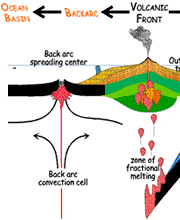
Backarc
The tectonic region on the landward side of a volcanic arc. Image by USGS.
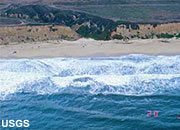
Backwash
The seaward rush of water down a beach that occurs with a receding wave.
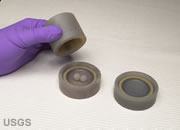
Ball Mill
A device used to reduce the particle size of laboratory specimens, dry chemicals, mined ores, and other solid materials. The material to be reduced in particle size is sealed in a durable cylindrical container along with two or more balls made out of mineral material or metal. The cylinder is then placed in a machine that rolls or shakes it vigorously while the balls inside repeatedly impact the material, reducing it to a powder. Ball mills can be as small as the one shown in the photo (for grinding laboratory specimens), or they can be cylinders over ten feet tall and twenty feet long that are loaded with many tons of ore from a mine and used to pulverize it to a fine particle size.

Banded Iron Ore
A rock that consists of alternating layers of jasper and an iron oxide mineral (usually hematite), with the iron oxide in high enough concentration to be of economic value.
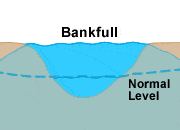
Bankfull Stage
A height of water in a stream that completely fills the natural channel. If the water rises any higher, it will overtop the banks of the stream and a flood will occur.

Bank Storage
Water that seeps into the ground along the banks of a stream during a time of high flow. This loss of water into the ground slightly reduces the height that the stream will attain and then slowly seeps into the stream as the high water level subsides - hence the term "bank storage."

Bar
An underwater ridge, usually of sand and/or gravel, that forms from the deposition and reworking of sediments by currents and/or waves. Bars occur in rivers, river mouths, and in offshore waters. The photo shows a sand bar in a river at low water level.
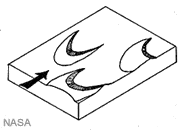
Barchan
A sand dune that is crescent-shaped in map view. Barchan dunes form in areas of limited sand supply. They move across the desert floor with their gently sloping convex sides facing upwind and their steeply sloping concave sides facing downwind.

Barrier Island
A long, narrow island composed of sediment that parallels a shoreline. Shown in the photo are some of the Chandeleur Islands, barrier islands that stand between the Gulf of America and the Louisiana coastline. During storms, the barrier islands absorb some of the wave energy that would otherwise batter the coastline. Their geometry can be significantly changed during these storms.
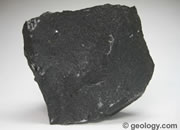
Basalt
A dark-colored, fine-grained extrusive igneous rock composed mainly of plagioclase feldspar and pyroxene. Similar in composition to gabbro. Basalt is thought to be one of the main components of oceanic crust and is the most common rock type of lava flows on land.
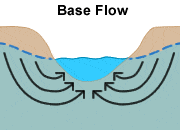
Base Flow
Water that seeps into a stream through a permeable rock or sediment unit that outcrops in the bottom or banks of the stream.
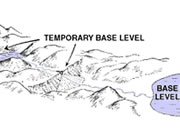
Base Level
The lower limit of erosion by a stream. Sea level is the ultimate base level. However, lakes, dams, and other locations of low water flow can serve as a temporary base level in upstream areas.
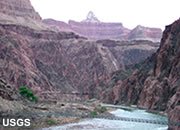
Basement
The igneous and metamorphic rocks that exist below the oldest sedimentary rock cover. In some areas, such as shields, the basement rocks may be exposed at the surface. The rock at river level in the photo is the Vishnu Schist, basement rock in the Phantom Ranch area of the Grand Canyon.

Basic Rock
An igneous rock that has a relatively low silica content. Examples are gabbro and basalt. Also see entries for acidic, intermediate, and ultrabasic rocks.
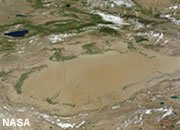
Basin
In tectonics, a circular, syncline-like depression of strata. In sedimentology, the site of accumulation of a large thickness of sediments. Shown in the photo is the Tarim Basin of China, which is occupied by the Taklimakan Desert, a large desert in China.
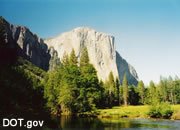
Batholith
A very large intrusive igneous rock mass that has been exposed by erosion and that has an exposed surface area of over 100 square kilometers. A batholith has no known floor. Shown in the photo is El Capitan, a famous granite outcrop in Yosemite National Park. The granites exposed in Yosemite and much of the surrounding area are part of the Sierra Nevada Batholith.
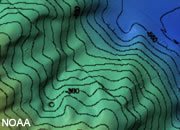
Bathymetry
The measurement of ocean depths and the preparation of maps that display water depth or the topography of the ocean floor.
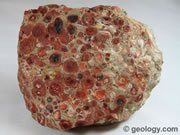
Bauxite
The most important ore of aluminum. A mixture of aluminum oxides and hydroxides that forms from intense chemical weathering of a soil in tropical environments.
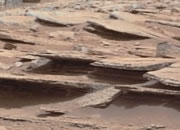
Bedding
The characteristic structure of sedimentary rocks in which layers of different composition, grain size, or arrangement are stacked one on top of another in a sequence with oldest at the bottom and youngest at the top. The photo of bedded rock units in the image was acquired by NASA's Mars Rover Curiosity in the Gale Crater of Mars.
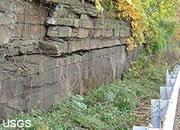
Bedding Plane
A distinct surface of contact that separates the layers of a sedimentary rock unit.
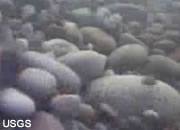
Bed Load
The larger, heavier particles that are being transported by a stream. Instead of being dissolved or suspended, these are being rolled or bounced along, spending at least part of their time in contact with the stream bottom.
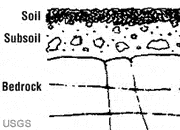
Bedrock
Solid rock present beneath any soil, subsoil, sediment, or other surface cover. In some locations it may be exposed at Earth's surface.
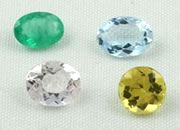
Beryl
"Beryl" is a beryllium aluminum silicate mineral with a chemical composition of Be3Al2Si6O18. It has historically been used as an ore of beryllium, but is better known as the mineral of several gem varieties based upon color. Green beryl is emerald. Blue is aquamarine. Pink is morganite. Yellow and yellow-green are heliodor. Red is red beryl. Clear is goshenite.
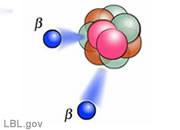
Beta-Particle
A particle emitted with high energy and velocity from the nucleus of an atom during radioactive decay. It can be equivalent to an electron or a positron.
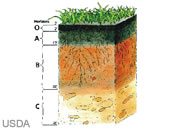
B-Horizon
A layer in the soil, below the A-horizon, where materials leached from above accumulate. Typically enriched in iron, clay, aluminum, and organic compounds.
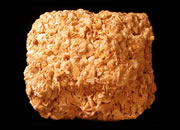
Biochemical Rocks
A sedimentary rock that forms from the chemical activities of organisms. Organic (reef and fossiliferous) limestones and bacterial iron ores are examples. The photo is a specimen of coquina, a variety of limestone composed primarily of shell debris.
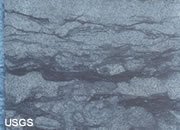
Bioturbated
An adjective used in reference to a sediment or sedimentary rock. Bioturbated sediments have been disturbed by animals (such as burrowing worms or shell fish) or plant roots. These have penetrated the sediment and disturbed any or all original sedimentary laminations and structures. Bioturbated rocks were disturbed in this way while still in the soft sediment phase of their formation.
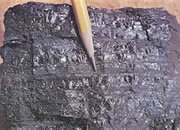
Bituminous Coal
A rank of coal that falls between anthracite and semi-bituminous. The most abundant rank of coal. Frequently referred to by the layman as "soft coal." It is most often composed of bright and dull bands. The bright bands generally represent well-preserved woody materials. The dull bands generally represent degraded woody materials and mineral matter.
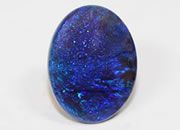
Black Opal
The name "black opal" is used for an opal with a black base color. This opal has blue play-of-color on a black base and is from Lightning Ridge, Australia. There are many types of opal.
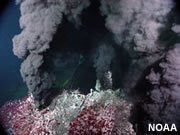
Black Smoker
A hot spring on the sea floor, usually near mid-ocean ridges, that discharges hot water laden with dissolved metals and dissolved gases. When these hot fluids contact the cold ocean water, the dissolved materials precipitate, producing a dark plume of suspended material. The water discharged from these springs is sea water that percolates down into the earth through fissures in the sea floor. This water is heated and picks up dissolved gases and metals as it interacts with the hot rocks and magma at depth. Also known as a "hydrothermal vent."
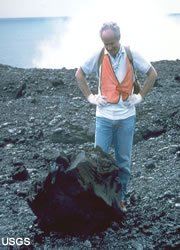
Block
Also known as "volcanic block." A rock greater than 64 millimeters in diameter that was ejected from a volcano during an explosive eruption. They are typically pieces of the volcanic cone that were torn loose during the eruption rather than a mass of molten ejecta that solidified in flight. The block in the photo was found on Kilauea Volcano, Hawaii.
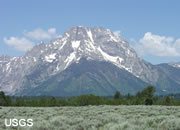
Block Fault Mountain
A linear mountain that is bounded by normal faults. Also known as "fault-block mountain." The photo shows Mount Moran, near Jackson Lake Junction, Wyoming. Mount Moran is part of the Teton Range, a block-faulted mountain range.

Block Slide
A type of mass wasting in which rock debris detaches and slides down a slope under the influence of gravity. The movement usually occurs over a planar surface such as a bedding plane, joint surface, or fault plane, with the moving material remaining in a large coherent mass.
|
Dictionary of Geological Terms - Only $19.99 All scientific disciplines have an essential vocabulary that students and professionals must understand to learn and communicate effectively. A geology dictionary that is used regularly is one of the most important tools for developing professional competence. A good dictionary should be on the desk of every geologist and within easy reach. This dictionary is compact and inexpensive at only $19.99. More information. |
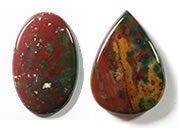
Bloodstone
Bloodstone is a dark green variety of jasper that has numerous splashes of red color. These red splashes remind people of blood, and that is how the stone received its name.
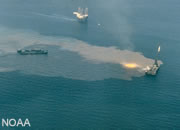
Blowout
A sudden, uncontrolled release of pressure from an oil or gas well that is triggered when the drill bit penetrates a pressurized rock unit. This release can blow the drill string and drilling fluid out of the well, followed by a rush of water, oil and natural gas. These were a greater danger in the early days of drilling. Today, blowout preventers and improved drilling and control methods are usually able to prevent them. The photo shows the Ixtoc I blowout that occurred in the Gulf of America in 1979.
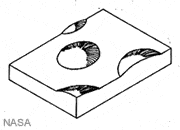
Blowout Dunes
Small, shallow, round or trough-shaped depressions in sand or dry soil that are formed by wind erosion. The material removed by the wind may also be referred to as "blowout."
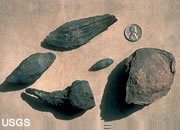
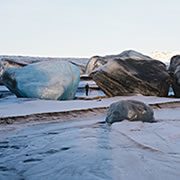
Boulder
A term used for a sedimentary particle that is larger than 256 millimeters in size. Boulders are the largest particles of sediment that occur in streams and can reach the size of a small house. The image shows rounded boulders of glacial ice deposited on an outwash plain in Iceland (with an adult human for scale). Yes, in some locations, ice can be a sedimentary particle!
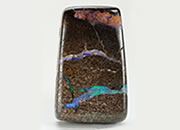
Boulder Opal
"Boulder opal" is a name used for a rough or cut material that displays precious opal within its surrounding rock matrix. There are many types of opal.
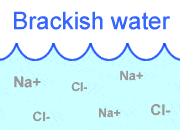
Brackish Water
Brackish water contains dissolved sodium chloride in amounts greater than that of fresh water, but less than that of sea water. (Average sea water contains about 35 g/L of dissolved sodium chloride.)
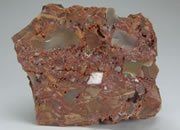
Breccia
A clastic sedimentary rock that is composed of large (over two millimeter diameter) angular clasts. The spaces between the clasts can be a matrix of smaller particles or a mineral cement that binds the rock together. The photo shows a piece of chert breccia; that is, a breccia in which the clasts are composed mainly of chert.
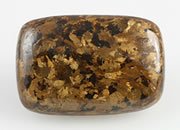
Bronzite
A bronze to greenish variety of enstatite with a metallic luster that is sometimes cut and polished as a gemstone.
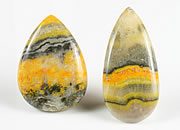
Bumblebee
Often called Bumblebee "Agate" or "Jasper," it is instead a rock formed at several volcanic vents in Indonesia. Some specimens reportedly contain arsenic. Although many cutters coat their stones with acrylic or resin, it is not recommended for use in jewelry or other uses that will place it in extended contact with your skin.
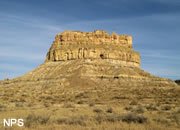
Butte
A conspicuous hill with steep sides and a flat top. The top is usually a cap-rock of resistant material. This structure is frequently an erosional remnant in an area of flat-lying sedimentary rocks. The photo shows the south face of Fajada Butte, Chaco Culture National Historical Park.
|
| More General Geology |
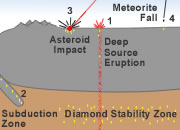 |
Diamonds from Coal? |
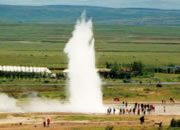 |
What is a Geyser? |
 |
What is the San Andreas Fault? |
 |
Igneous and Volcanic Features |
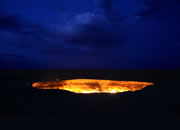 |
The Doorway to Hell |
 |
Topo Maps |
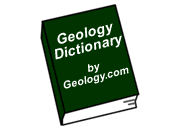 |
Geology Dictionary |
 |
Gifts That Rock |

Find Other Topics on Geology.com:

|

| ||

|

| ||

|

| ||

|

|

